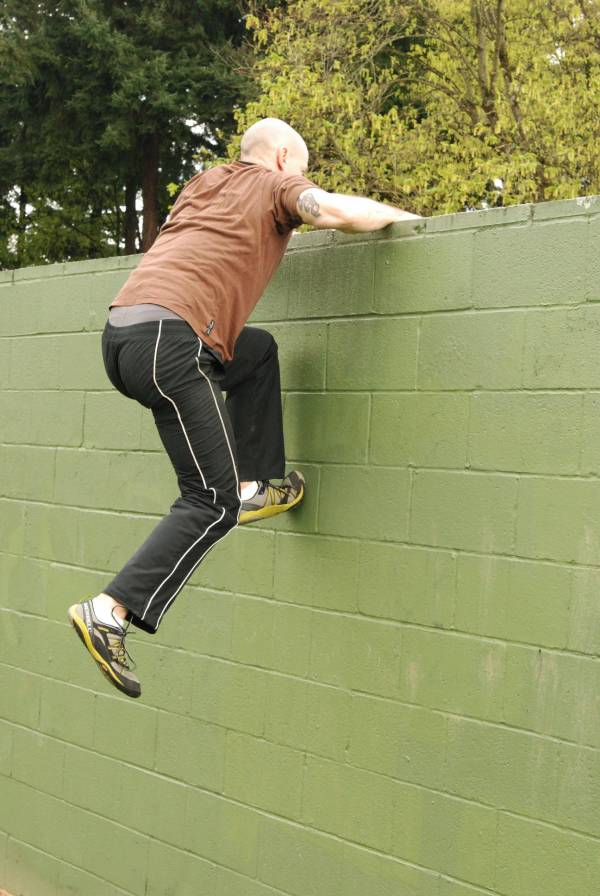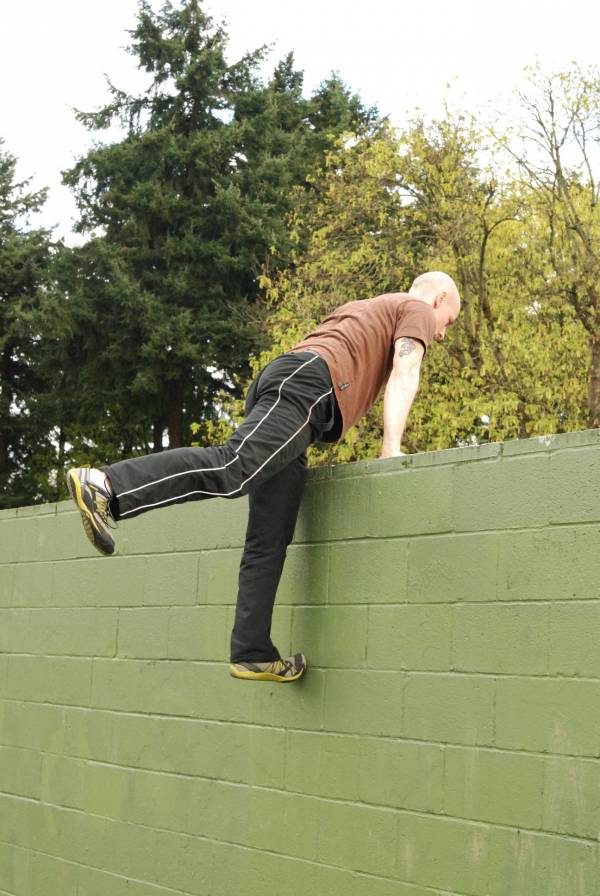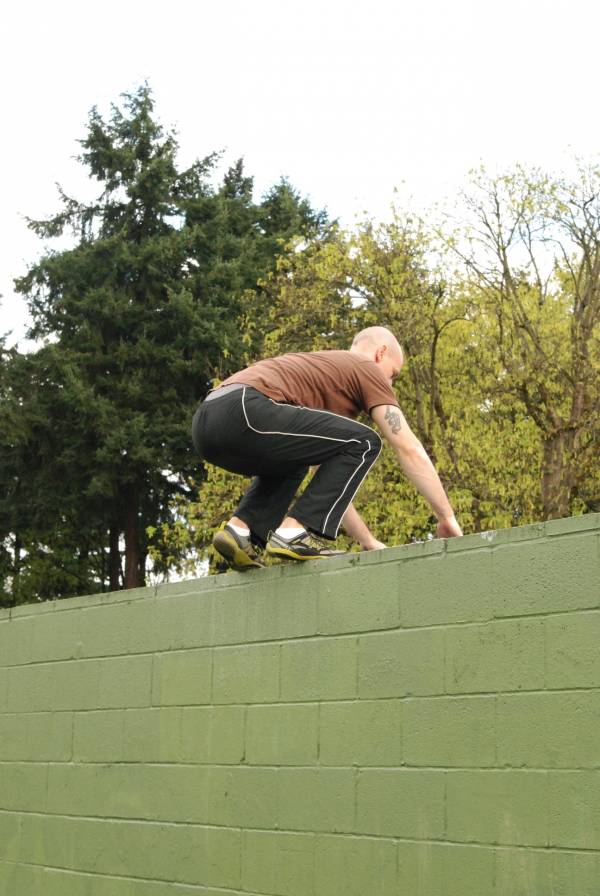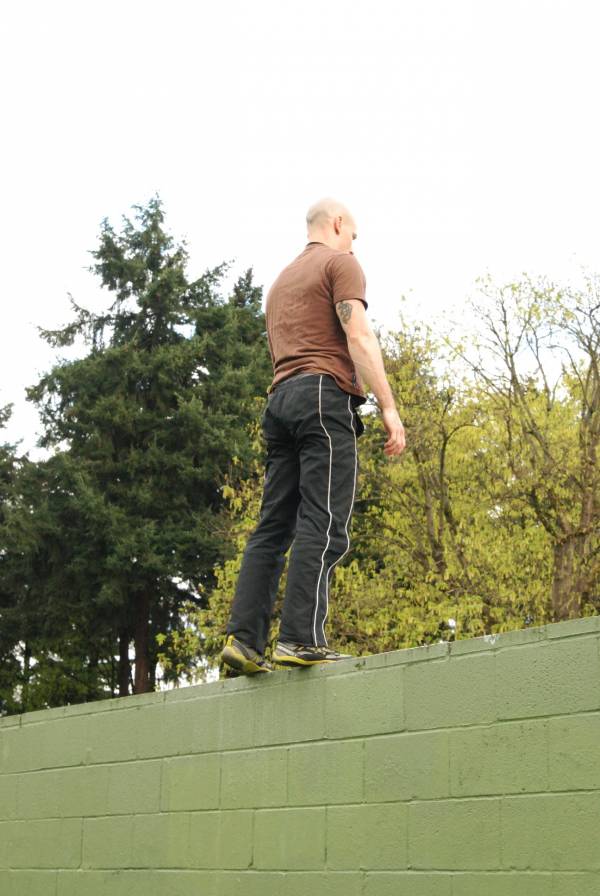Strict chest to bar pull-ups? You can crank those out without batting an eye. Dead-hang muscle-ups? You’ve got those, no problem. What comes next? What other upper-body dominant movements are there to master in the realm of functional, body-weight skills? How about simply being able to pull yourself up and on top of a wall?
In the parkour community, this movement, when performed from a hang, is known as a “climb-up.” It is a fundamental skill for getting yourself on top of an overhead structure. And aside from being a challenging and fun skill to master, the climb-up could just save your life someday. I’m not joking. Think about running away from an assailant or hightailing it to safety from a rushing flash flood. Being able to put some vertical distance between you and a threat is a great way to escape peril.
Now, most people with a solid baseline of physical fitness could probably get themselves on top of a wall if pressed to do so in an emergency. How fast he or she could do it is another matter. Not to be too dramatic, but when your life depends on it, speed and efficiency are of the utmost importance.
So, without further adieu, here is the fastest way (from a dead-hang) to get yourself on top of a wall using the climb-up:
- Grasp the top of a wall with both hands, with as much palm surface area as you can.
- Lower until your arms are almost fully extended and resting on the tension in your lats.
- Position your feet on the wall so that they are staggered with one leg flexed and placed close to your torso. The other foot should be placed on the wall approximately eighteen inches lower. (Note: the first photo shows reversed foot placement. The author switched feet before climbing upward.)
- In one explosive motion, drive your upper leg into the wall while pulling yourself upward with your arms.
- Kick your lower leg backwards and circle it forward as you lift your chest above the height of the wall.
- Pop your chest upward by forcefully pressing downward through your arms and simultaneously bringing both feet to land between your hands.
- Stand up. You’re on top of the wall!




Sounds incredibly easy, right? The technique just described can actually be quite difficult to master and, unless you’re a motor-learning savant, you’ll probably find that you must first use a few intermediate steps.
Getting your elbows and then one knee on top of the wall before standing up is often referred to as a “struggle up,” but it can be a helpful first step. After that, skip the knee and try to place one foot on top of the wall at a time. As you get more proficient at exploding upward, the idea is to be able to pop upward and land on top of the wall in a squat with both feet simultaneously.
Ryan Ford, of APEX Movement and the Demon Drills YouTube Channel, has an excellent video demonstrating the different levels of climb-up proficiency. Watch it and see where you are at in your ability:
If you’re really having trouble getting the motion down, here are a few strengthening exercises to supplement your training:
- False grip hang – Dangle beneath a bar or from the wall, hanging on the tissue between your palms and your flexed wrists. This helps to build wrist strength and comfort in the starting position. (This muscle-up video includes an explanation of the false grip.)
- Cat hang pull ups – Hang beneath the lip of a wall with your arms straight and feet staggered. Pull your body up and try to bring your chin above the height of the wall before lowering and repeating.
- Wall dips – Positioning yourself above a wall with straight arms and your palms flat. Lower your chest to the wall and then press up lifting yourself back to the starting position. (Read this for more on this movement.)
Once you feel comfortable with a dead-hang climb-up, it’s fun to measure your efficiency with a simple benchmark test: five climb-ups for time. Hang beneath a wall, perform your first climb-up getting both feet on the wall and then lower yourself back down. Repeat the process until you’ve complete five full climb-ups. The timer starts from the initial dead-hang and stops once your feet land on the wall on the fifth rep.
What’s your best time? Can you guess how fast elite parkour athletes can crank out five reps?
Ten seconds.
Yep, you read that right. The best in the world can get themselves on top of a wall five times in a row in just ten seconds! Amazing. It gives you something to shoot for, doesn’t it?
There is a primordial pleasure in being able to get your body on top of an overhead structure. My guess is that once you learn the climb-up, it will start to have a prominent place in your bodyweight strength training.
Stay tuned for additional articles on how to apply the climb-up to functional situations, including running up a wall that is well above head height.






